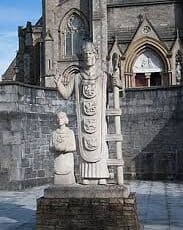
By November 1862 Lincoln needed to demonstrate to the public that his war effort was succeeding. While Antietam was a strategic success since it stopped the Confederate army, Lee’s army remained intact and quite capable of invading the north again. Lincoln replaced McClellan with General Ambrose Burnside who had a reputation as an independent commander and unlike McClellan, had no political ambitions (McClellan ran for President in 1864 and easily lost to Lincoln). Burnside assumed command on 7 November 1862 and planned a campaign against Lee. Burnside would strike at Fredericksburg, Virginia less than 60 miles from Washington and also 60 miles from Richmond. Burnside planned to cross the Rappahannock River on pontoon bridges, move through Fredericksburg and assault Lee who was arriving on Marye’s Heights, high ground overlooking Fredericksburg. The pontoon bridges were late and did not arrive until the end of November. By that time Lee had assembled his army and was prepared for Burnside’s attack.
Burnside had over 122,000 troops while Lee had over 75,000. Burnside’s troops included the Irish Brigade led by General Thomas Francis Meagher with five regiments: the 63rd, 69th,and 88th New York Volunteer Infantry, the 116th Pennsylvania and 28th Massachusetts.
There was nothing to stop the Army of the Potomac from taking the city of Fredericksburg in late November 1862. General Sumner, the Union Right Grand Division commander, could have had his troops wade across the Rappahannock at fords and unlock the door to Richmond. Instead, he was ordered by General Burnside to wait for pontoon bridges, so the moment was lost.
On the eve of General Burnside’s attack, the boys of the Irish Brigade were sure that there would not be a fight. One of the men went to Father William Corby, the Catholic chaplain of the 88th New York. “Father,” said this soldier, “they are going to lead us over in front of those guns which we have seen them placing, unhindered, for the past three weeks.” Father Corby told him: “Do not trouble yourself; your generals know better than that.”
Engineers began assembling the pontoon bridges on 11 December and by the 13th Burnside’s forces were across the bridges and moving through the town of Fredericksburg. Sumner sent in successive waves of Union troops that were repulsed with heavy casualties. The Irish Brigade’s turn came and by coincidence it was faced by Irish troops of McMillian’s 24th Georgia Infantry part of Thomas Cobb’s Brigade. Meagher ordered the advance and one of the Confederates spotted the green Irish flag “Oh God, what a pity! Here comes Meagher’s fellows.”
Private William McCarter tells what happened. “The storm of battle increased its fury and the crash of musketry, mingled with the roar of cannon from the peaks, was terrific. To reach the stone wall was the first object in view. We certainly tried hard to do it.
When a large part of the distance had been gained and we were within 50 paces of this wall, Cobb’s solid brigade of Rebel infantry, said to have been then 2,400 strong, suddenly sprang up from behind it. They had been entirely concealed from our view until that moment. The Rebs poured volley after volley into our faces, at once stopping our further progress. In connection with this fire, other Rebel infantry, in long lines behind earthworks and in rifle pits on Marye’s Heights, were blazing away at us at the same time. It was simply madness to advance as far as we did and an utter impossibility to go further.
General Meagher, who at this time was on the extreme left of his command, saw the very critical position of his men and the terrible slaughter that was being made among them with no prospect of success. He ordered the five regiments of his brigade, then pretty well torn up, to be closely massed together in double line of battle. This was at once done, taking up only a moment or two of their time. Meagher then gave the command, “Load and fire at will.” Away we went at it. A few moments after, I was very severely wounded in the thigh by a cannonball and carried off the field. That was the last time I saw General Meagher.”
Confederate General James Longstreet would later say “The charges had been desperate and bloody, but utterly hopeless.” Burnside withdrew in defeat on 15 December. Of the 1,200 men of the Irish Brigade 545 were killed, wounded or missing. It was a tragic Union defeat. Union losses were 12,653 killed, wounded or missing while Lee lost 5,377. Lincoln replaced Burnside with General Joseph Hooker a month later.



